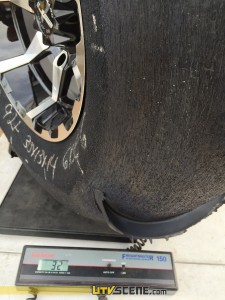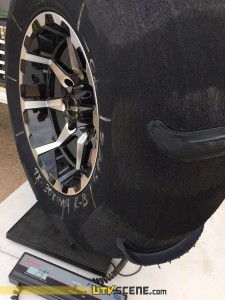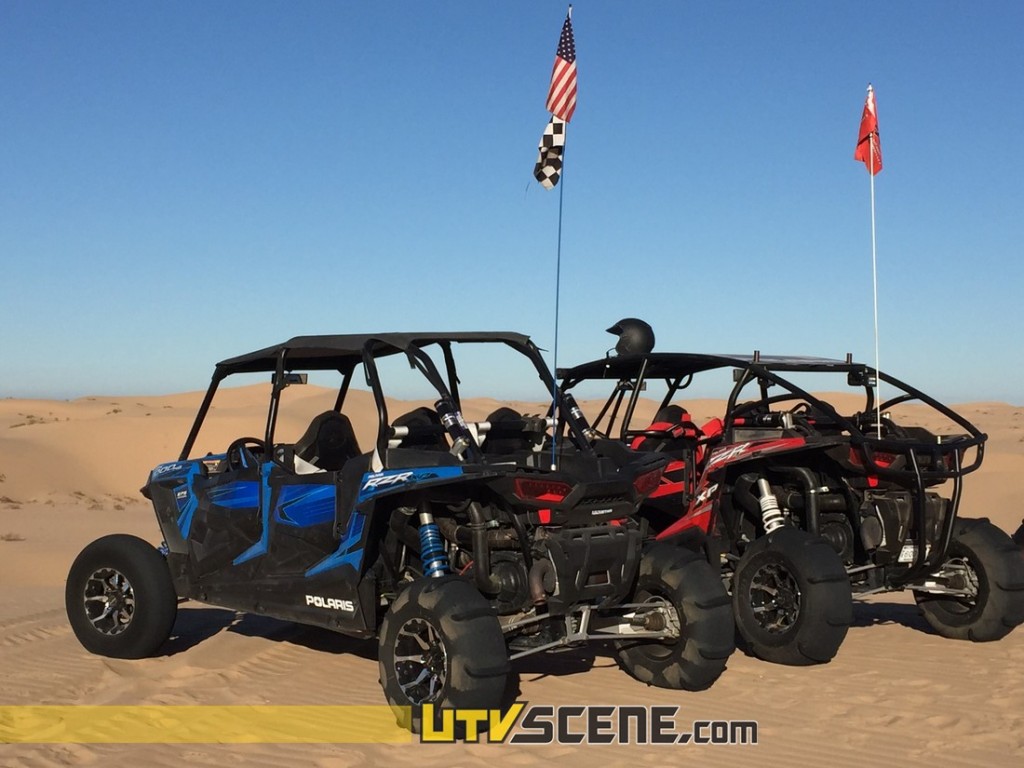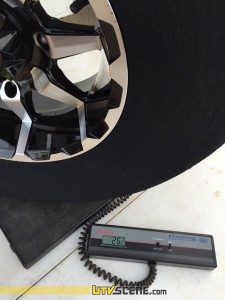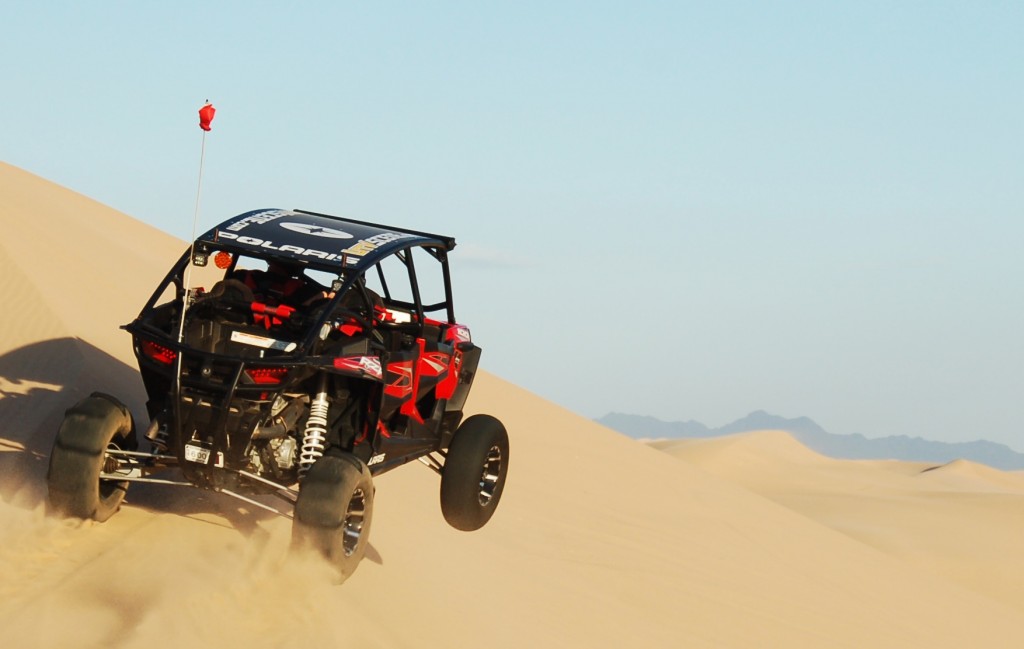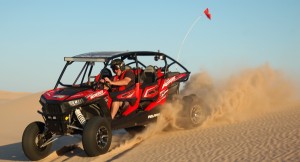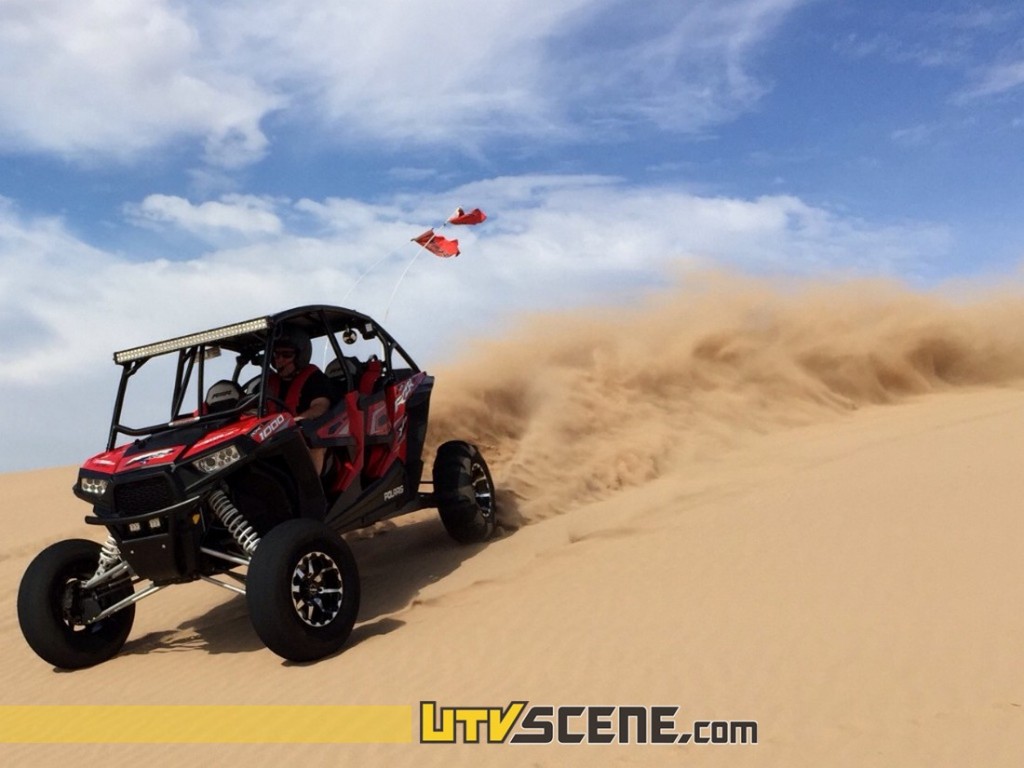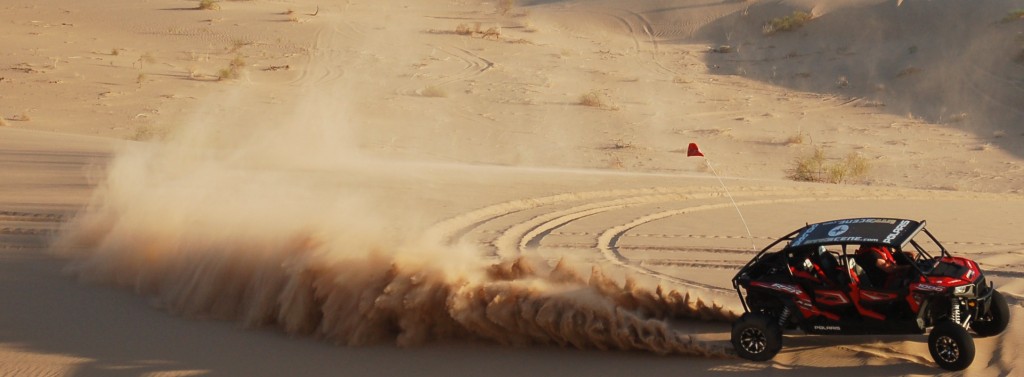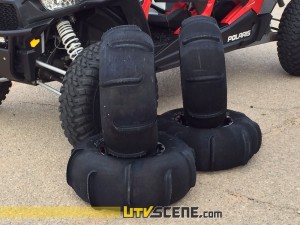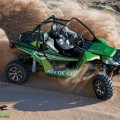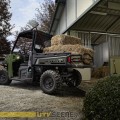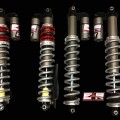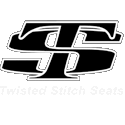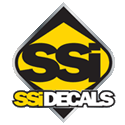Skat-Trak Sand Tire Test
- Updated: January 25, 2016
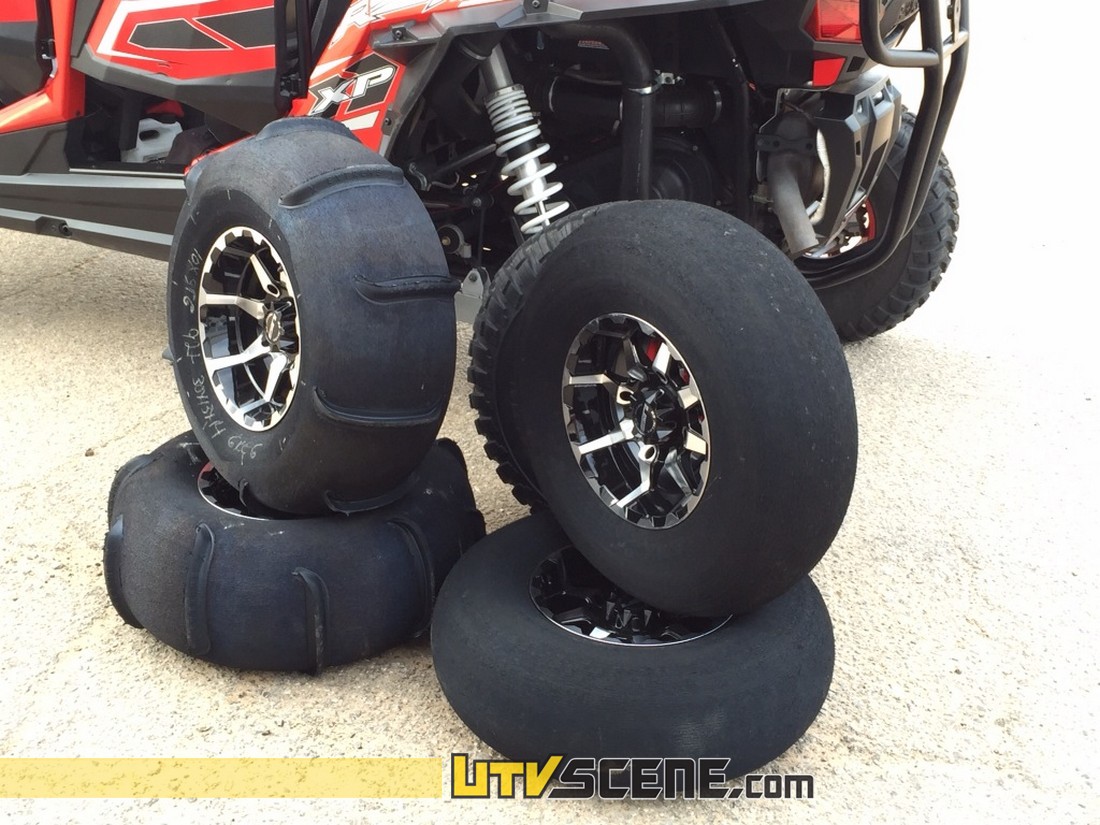
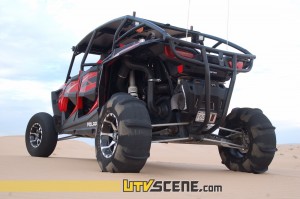 It seems recently that the onset of each sand season has delivered a new choice of at least one or two types and or manufactures of paddle tires for the SXS market. But where did the sand tire get its start? Who was it that invented what we call the paddle tire? The answer to both questions is Skat Trak, an all around performance oriented company from Southern California. At this past September’s Sand Sports Super Show we stopped by the Skat Trak booth where they had on display, of all things, their competitors tires! At the front of their booth was a line of scales, each of which had a different manufacturer’s paddle tire including the Skat Trak hanging from them. The display was a true comparison in the weights of all of Skat Trak’s competition. An important factor in the performance of any vehicle is tire weight & the amount of rotating mass the engine must overcome to turn them. This is especially true when you run on a surface like sand which creates incredible drag and a high amount of rolling resistance. After inspecting the weight of each different manufacturers tires hanging from the scales, the Skat Trak definitely has a distinct advantage over the competition when it comes to weight.
It seems recently that the onset of each sand season has delivered a new choice of at least one or two types and or manufactures of paddle tires for the SXS market. But where did the sand tire get its start? Who was it that invented what we call the paddle tire? The answer to both questions is Skat Trak, an all around performance oriented company from Southern California. At this past September’s Sand Sports Super Show we stopped by the Skat Trak booth where they had on display, of all things, their competitors tires! At the front of their booth was a line of scales, each of which had a different manufacturer’s paddle tire including the Skat Trak hanging from them. The display was a true comparison in the weights of all of Skat Trak’s competition. An important factor in the performance of any vehicle is tire weight & the amount of rotating mass the engine must overcome to turn them. This is especially true when you run on a surface like sand which creates incredible drag and a high amount of rolling resistance. After inspecting the weight of each different manufacturers tires hanging from the scales, the Skat Trak definitely has a distinct advantage over the competition when it comes to weight.
Unlike the competition’s tires that are originally constructed & molded to be paddle tires, the Skat Trak is much different. Skat Trak starts with a complete tire that they obtain from their selected manufacturers. Skat Trak then mounts the tire onto their special buffing lathe where they proceed to shave off all of the tire tread and excess rubber. They in fact buff the tire from the bead on one side all the way around to the bead on the other side.
This process effectively removes all of the excess rubber weight from the tire’s carcass. After the buffing is completed the tire carcass receives the number, size, and configuration of paddles desired by vulcanizing them onto the buffed tire. This process allows their customers an incredibly wide selection of paddle possibilities.
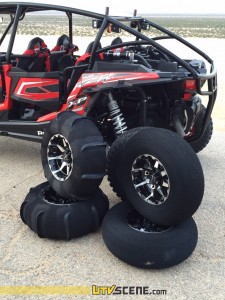 On a recent trip to Glamis we stopped off at Skat Trak in Calimesa Ca, to pick up two complete sets of sand tires. One of their two most popular sizes for the XP1K are the 30x11x14 with the Extreme Paddle in a 9 paddle configuration. The second is the 30x13x14 Extreme 10 paddle oriented in a staggered configuration. Up front it was the 30x11x14 “ruff buff” treadles tire. All eight tires were mounted on STI’s HD6 wheels with the paddles being on 9″ wide and the fronts buffs on 7″ wide wheels. So first things first, upon arrival at the dunes we checked and set each tire to ten psi, weighed each one, and then measured the roll out of each as well. For those who don’t know, “Roll Out” is defined as the distance across the ground that a tire travels in one revolution/rotation.
On a recent trip to Glamis we stopped off at Skat Trak in Calimesa Ca, to pick up two complete sets of sand tires. One of their two most popular sizes for the XP1K are the 30x11x14 with the Extreme Paddle in a 9 paddle configuration. The second is the 30x13x14 Extreme 10 paddle oriented in a staggered configuration. Up front it was the 30x11x14 “ruff buff” treadles tire. All eight tires were mounted on STI’s HD6 wheels with the paddles being on 9″ wide and the fronts buffs on 7″ wide wheels. So first things first, upon arrival at the dunes we checked and set each tire to ten psi, weighed each one, and then measured the roll out of each as well. For those who don’t know, “Roll Out” is defined as the distance across the ground that a tire travels in one revolution/rotation.
First up were the 30x11x14 ruff buff fronts. They weighed in at 26 lbs and the roll out measured in at 92 & 1/4″. The 30x11x14 Extreme 9 paddle weighed in at 29 & 1/4 lbs and the roll out measured in at 91 & 1/4″. Finally the largest of the tires, the 30x13x14 Extreme 10 paddle staggered tire was 32 lbs and roll out was measured at 94″. With that done it was finally time to put them on our Polaris RZR XP4. We started with the 30×11 Extreme 9 paddle tires. Coupled with the 30×11 buffed fronts and mounted on the stylish STI HD6 it made for a nice looking sand tire package for sure!
The first thing we noticed upon leaving out from camp was how easily our RZR seemed to roll across the sand. When throttled up, our XP4 seemed to jump forward with ease as if its rolling resistance was significantly reduced.
Another thing immediately noticed was that accelerating from low speeds didn’t cause the rear of the RZR to sink or dig in like other tires we’ve used. Rather it seemed to stay on top of the sand and simply and quickly accelerate forward. Pressing on out into the bigger and faster dunes and bowls the tires really seemed to perform well.
The higher speed running continued to show the tire having little trouble staying on top of the sand and delivering a light easy rolling ride. As we made our way deeper out into the dunes we encountered some slower, tighter and much softer sand. In this case we felt the effects of the narrower profile of the 30×11 Extreme 9 paddle. When faced with climbing steep soft faces at lower speeds we felt that the tire didn’t provide the same floatation that we felt on the bigger, faster and more firm sand dunes. Considering that we were running an XP4 which is heavier and has a completely different weight bias then the standard 2 seat XP could also have been a factor in this result. Overall the 30×11 Extreme tire performed well for both normal and aggressive riding in the dunes. Low speed power sliding as well as high speed, high G force drifting were both fun and predictably controlled with the 30×11 Extreme. On day two we mounted up the larger 30×13 Extreme 10 paddle.
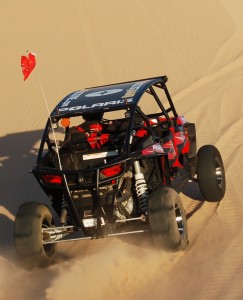 Once mounted on our RZR XP4 the 30×13’s were noticeably bigger in overall size. As we rolled out with them we felt the same type of easy acceleration and flotation as we did with the 30×11. However the 30×13 definitely performed better for our RZR XP4 in the tight softer, steeper dunes when running at lower speeds.
Once mounted on our RZR XP4 the 30×13’s were noticeably bigger in overall size. As we rolled out with them we felt the same type of easy acceleration and flotation as we did with the 30×11. However the 30×13 definitely performed better for our RZR XP4 in the tight softer, steeper dunes when running at lower speeds.
The larger tire was able to stay on top of the softest sand better than its narrower counterpart. As we stated earlier perhaps the 30×11 would deliver a better result on a shorter and lighter 2 seat RZR XP in low speed very soft conditions. When it comes to duning the 30×13 is a great tire for the XP4. Power slides & high speed drifts were fun and controlled.
The bigger tire delivers along with more floatation quite a lot more side bite while traversing off camber slopes and bowls. We were very impressed with the bigger tires ability to really stick while traversing high speed bowls and side slopes! If you’ve ever been side hilling and didn’t like suddenly having the back end break loose causing it to drop down the face of the slope and put you into a side slide then this is the tire for you. The taller profile and extra side bite was also noticeable on high speed, high G force turns. We ran the same Skat Trak 30x11x14 buffed front tires when testing both sets of rear Extreme paddles. The buffed front tires performed excellently when paired with either size of rear tire. The steering was always light and precise without any under steering issues as some who haven’t run a treadles tire might expect. Comparing the 30×11 nine paddle Extreme, and 30×13 ten paddle Extreme, both worked well overall while they each provided different characteristics. The Skat Trak tires deliver advantages in reduced weight and paddle size, count, and configuration that other paddle tire manufacturers just can’t match.
